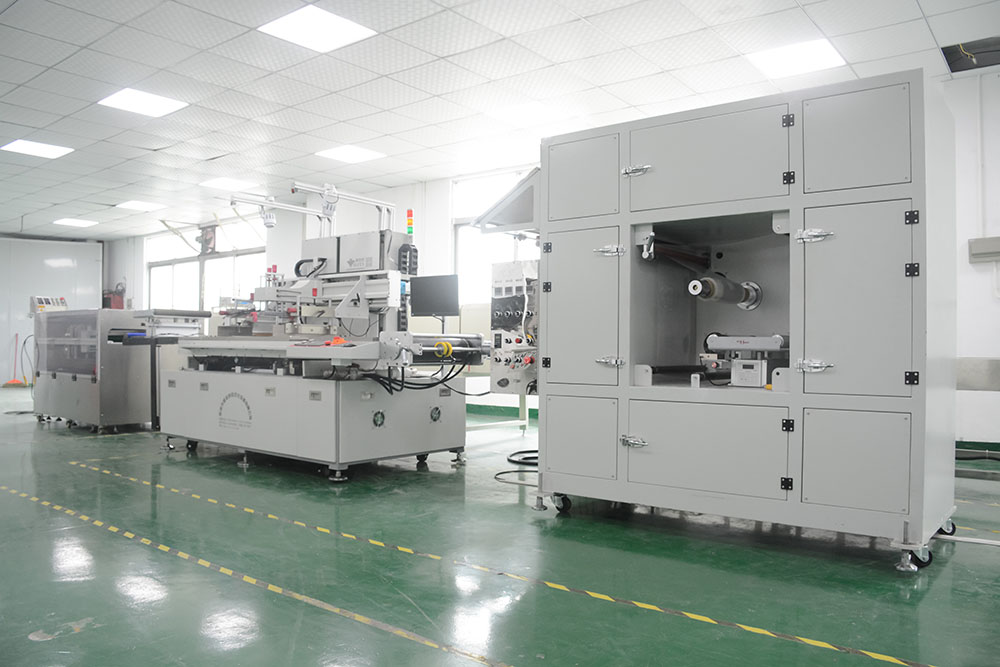คู่มือการผลิตการพิมพ์สกรีนแผงวงจรพิมพ์
คู่มือการผลิตการพิมพ์สกรีนแผงวงจรพิมพ์
ในแผงวงจรพิมพ์, ลามิเนตหุ้มทองแดงใช้กันอย่างแพร่หลาย. นอกจากการขุดเจาะแล้ว, การเคลือบรูและการชุบด้วยไฟฟ้าของวงจร, กระบวนการผลิตแผงคู่โดยทั่วไปจะเหมือนกับลามิเนตด้านเดียว. หลังจากตัด, การรักษาพื้นผิว, เจาะ, การทําให้เป็นโลหะของหลุม, ชุบทองแดงและการพิมพ์สกรีน.

Roll to Roll Flat Bed เครื่องพิมพ์ซิลค์สกรีน
1) การทําสกรีนเป็นกุญแจสําคัญในการพิมพ์สกรีนแผงวงจร.
จําเป็นต้องใช้หน้าจอ, กรอบหน้าจอและวัสดุไวแสงอย่างถูกต้อง. การไหลของหมึกควบคุมหน้าจอ, ความหนาของการพิมพ์และกําหนดความทนทานของหน้าจอ. โดยทั่วไป, ความตึงเครียดสูง, เส้นใยเดี่ยว, ควรเลือกลวดตาข่ายโพลีเอสเตอร์ทอธรรมดาหรือลวดตาข่ายสแตนเลส. นอกจากนี้, หน้าจอใหม่ควรหยาบและล้างไขมันเพื่อให้มั่นใจในคุณภาพของแผ่นตาข่ายและยืดอายุการใช้งานของหน้าจอ. โดยทั่วไปจะเลือกกรอบตาข่ายอลูมิเนียมแรงดึงสูง, และคุณภาพก็เหมาะ. เป็นสิ่งสําคัญมากที่จะต้องใส่ใจกับการปรับและควบคุมความตึงเครียด. โครงตาข่ายที่ยืดออกควรอยู่บนเครื่องปรับความตึงนานกว่า 48 ชั่วโมง.
การควบคุมความตึงของหน้าจออย่างสมเหตุสมผลควรใส่ใจกับความสม่ําเสมอของความหนาของหน้าจอ, ความสม่ําเสมอของการเปิดรับแสง, ความทนทานของหน้าจอ. ปรับและควบคุมระยะห่างหน้าจอได้อย่างแม่นยํา, ตำแหน่ง, ความเสถียรของมิติ, การใช้หมึกและการใช้พลังงานในกระบวนการพิมพ์. ควรให้ความสนใจในการควบคุมปัจจัยที่ส่งผลต่อความตึงเครียด, และการเลือกอุปกรณ์และวิธีการความตึงเครียดที่เหมาะสม. สารไวแสง Diazo และฟิล์มไวแสงมักใช้ในวัสดุไวแสงแบบแผ่น. อิมัลชันไดอะโซเนียมใช้กันอย่างแพร่หลายในการพิมพ์สกรีน. ฟิล์มไวแสงมีลักษณะของฟิล์มที่สม่ําเสมอและควบคุมได้, ความละเอียดสูง, ทนต่อการสึกหรอสูงและยึดเกาะได้ดีกับหน้าจอ. มีการใช้กันอย่างแพร่หลายในการพิมพ์ตัวอักษรของกระดานพิมพ์. จําเป็นต้องใส่ใจกับความหนาของฟิล์ม. โดยทั่วไป, 25 แนะนําให้ใช้ μ M-30 μ ม. สําหรับการพิมพ์หน้ากากประสาน, และ 15 μ m-20 μ m สําหรับลวดพิมพ์และตัวอักษร.
2) การพิมพ์ฟิล์มต้านทาน
การออกแบบกลุ่มวงจรที่พิมพ์บนลามิเนตเพื่อสร้างฟิล์มป้องกันการกัดกร่อนเสร็จสมบูรณ์โดยการพิมพ์สกรีน. การพิมพ์สกรีนมีสองประเภทพร้อมฟิล์มป้องกันการกัดกร่อน. หนึ่งคือการใช้หมึกป้องกันการกัดกร่อนในการพิมพ์ชิ้นส่วนวงจร, นั่นก็คือ, เพื่อพิมพ์หมึกป้องกันการกัดกร่อนในส่วนที่ต้องเก็บฟอยล์ทองแดง. ด้วยวิธีนี้, ส่วนวงจรจะถูกเก็บไว้ในระหว่างการกัดกร่อนเพื่อสร้างวงจรนําไฟฟ้า. ที่สอง, ห้ามใช้วงจรพิมพ์หมึกป้องกันการกัดกร่อน, ตรงกันข้ามกับวงจรพิมพ์นอกชิ้นส่วน. นั่นคือทําให้ชิ้นส่วนภายนอกวงจรมีความต้านทานการกัดกร่อน. เมื่อติดตั้งส่วนประกอบแล้ว, แผงวงจรสองด้านและหลายชั้นเกือบจะพิมพ์ด้วยวิธีนี้.
ควรใช้ดีบุกบัดกรีหรือทองคําในการชุบด้วยไฟฟ้า, และควรใช้สารละลายชุบทองแดงฟลูออโรบอเรตสําหรับการบัดกรีดีบุก. อัตราส่วนของดีบุกต่อตะกั่วในดีบุกบัดกรีคือ 3:2. สารละลายกรดอ่อนใช้สําหรับการชุบทอง. ฟิล์มหมึกป้องกันการกัดกร่อนของการชุบด้วยไฟฟ้าต้องสามารถทนต่อการกัดกร่อนของน้ํายาปรับสภาพและสารละลายชุบด้วยไฟฟ้า, และในที่สุดก็สามารถถอดออกได้. เมื่อชุบด้วยไฟฟ้าวงจร, ควรชุบทองแดงให้มีความหนาที่กําหนดก่อน, จากนั้นก็ชุบบัดกรี. ความหนาของการชุบด้วยไฟฟ้าคือ 30 μ ม. สําหรับทองแดง, 10 μ ม. สําหรับการบัดกรีและ 25 μ ม. สําหรับทองคํา. หลังจากชุบด้วยไฟฟ้า, ฟิล์มป้องกันการกัดกร่อนลอกออกโดยใช้น้ํายาล้างหมึกและแปรงขนนุ่ม.
3) การพิมพ์หน้ากากประสาน
แผงวงจรพิมพ์ที่ทําความสะอาดแล้วหลังการแกะสลักควรพิมพ์สกรีนด้วยหน้ากากประสานทันที. หมึกหน้ากากประสานถูกนําไปใช้กับแผงวงจรพิมพ์. อย่างไรก็ตาม, พารามิเตอร์กระบวนการของเครื่องพิมพ์สกรีนที่แตกต่างกันแตกต่างกัน. โดยทั่วไป, ความเร็วในการพิมพ์ถูกควบคุมที่ 100 มม. / วินาที – 150 มิลลิเมตร / s, ความดันการพิมพ์สกรีนคือ 4.0kg / c㎡ – 6.0กก./ซม.², ความแข็งของใบมีดคือ 65 องศา, มุมใบมีดคือ 65 องศา – 70 องศา, จํานวนมีดโกนคือ 1 / หน้า – 2 / พื้นผิว, และระยะห่างของหน้าจอคือ 4 มิลลิเมตร – 8 มิลลิเมตร. ก่อนการพิมพ์สกรีน, จําเป็นต้องเอียงเปลือกเครื่องพิมพ์สกรีนและพื้นผิวโต๊ะทํางาน. ก่อนพิมพ์แผ่นแรก, จําเป็นต้องทําความสะอาดพื้นผิวหน้าจอด้วยเปลและลองพิมพ์หลาย ๆ ครั้งด้วยกระดาษสีขาว. โดยทั่วไป, ต้องทําความสะอาดโต๊ะทํางานทุกสองชั่วโมง. ก่อนการพิมพ์สกรีนอย่างเป็นทางการ, ต้องดําเนินการพิมพ์ทดลอง, และควรตรวจสอบคุณภาพของแผ่นพิมพ์เพื่อให้แน่ใจว่าน้ํามันพิมพ์สม่ําเสมอและความหนาสม่ําเสมอ, และไม่มีปรากฏการณ์ของน้ํามันหรือน้ํามันที่ไม่ดีเข้าไปในหลุม, ไม่มีขยะและฝุ่นละออง, ฯลฯ. ต้องวางแผ่นที่พิมพ์สกรีนไว้บนกรอบแผ่นเป็นระยะๆ, และสามารถอบล่วงหน้าในเตาอบได้หลังจาก 10 ถึง 15 รายงานการประชุม.
ในการพิมพ์สกรีน, ใส่ใจกับการควบคุมความหนาของหน้ากากประสาน. สามารถเลือกแผ่นหน้ากากประสานที่พิมพ์ด้วยหน้ากากประสานได้, และรหัสสินค้า, หมายเลขแบทช์และประเภทของหน้ากากประสานที่ใช้จะต้องระบุไว้ในรายงานที่ระบุ. แล้ว, ตามความต้องการของส่วนต่าง ๆ ของตัวอย่างที่จะทดสอบ, ด้วยแผ่นมือพิเศษสําหรับการปิดส่วนโลหะวิทยา. ความหนาของหน้ากากประสานทั้งสองด้านของเส้นไม่ควรน้อยกว่า 5 μ ม., และความหนาของหน้ากากประสานตรงกลางบรรทัดไม่ควรน้อยกว่า 10 μ ม.. ความแข็งของดินสอควรถึง 6h-7h. หากพื้นผิวฟิล์มเหนียว, หมายความว่าเวลาในการบ่มไม่เพียงพอหรือฟิล์มหนาเกินไป. เวลาในการบ่มหรือชั้นฟิล์มสามารถขยายได้อย่างเหมาะสม.
 เครื่องพิมพ์สกรีน
เครื่องพิมพ์สกรีน